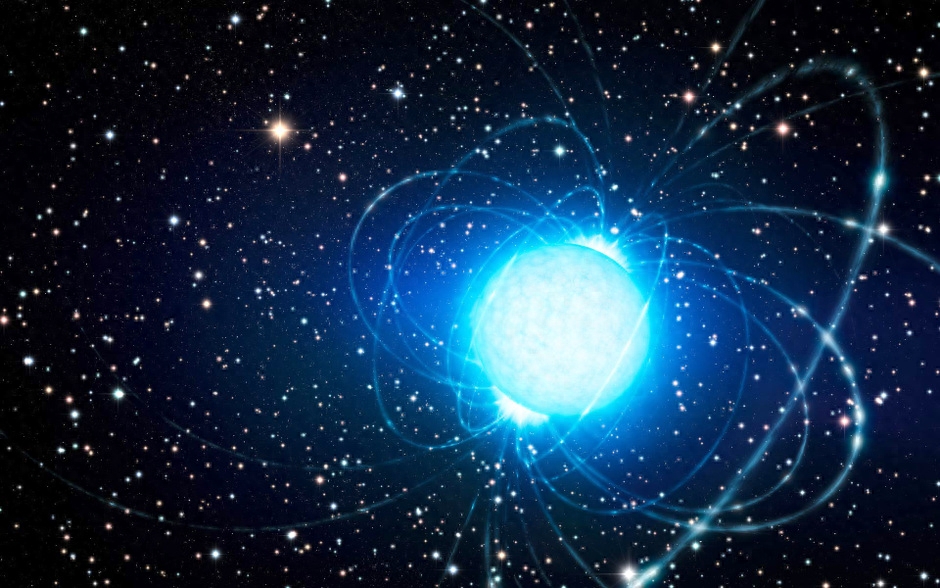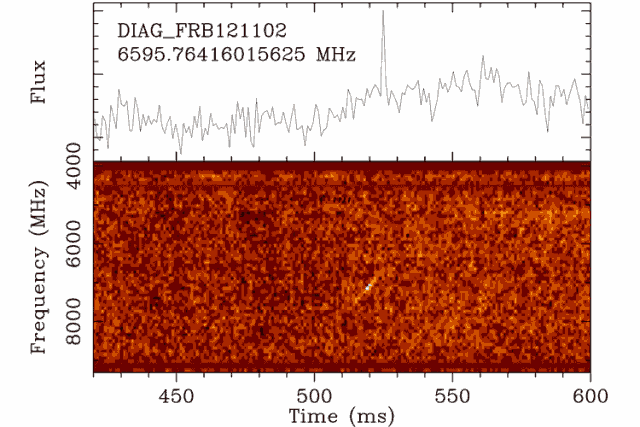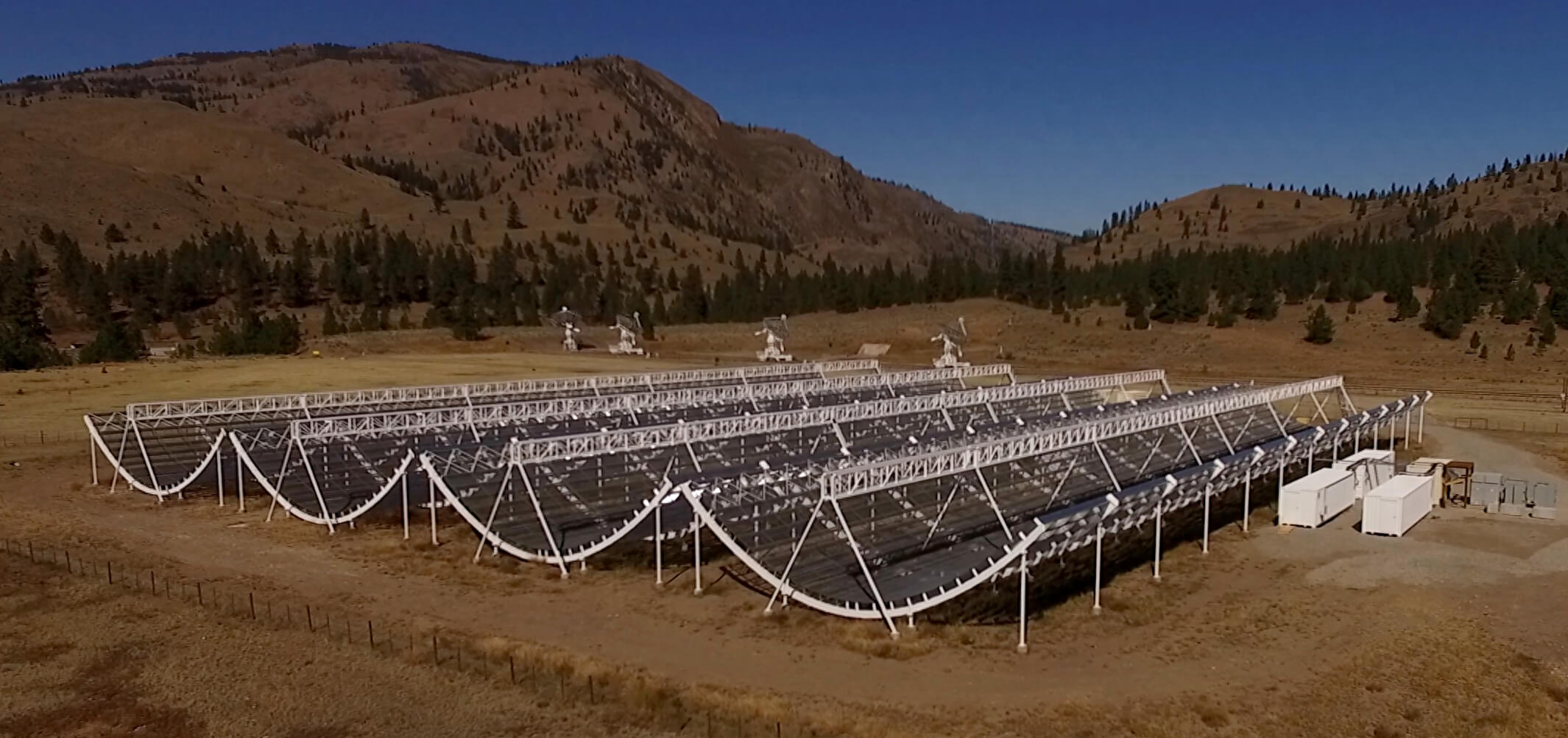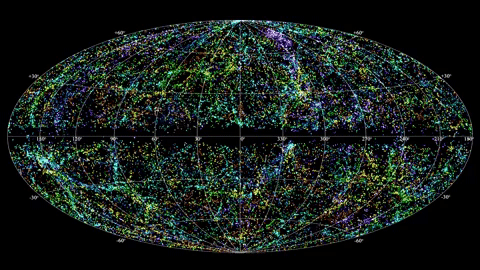A telescope in Canada captured 13 fast radio bursts in two months, including a very unusual repeating radio wave that came from 1.5 billion light-years away.
Produced by: Popular Science China
Produced by: Zuo Wenwen, Shanghai Observatory, Chinese Academy of Sciences
Producer: Computer Network Information Center, Chinese Academy of Sciences
A telescope in Canada captured 13 fast radio bursts in two months, including a very unusual repeating radio wave that came from 1.5 billion light-years away. Two related papers were simultaneously published in the world's top academic journal, the British "Nature" magazine, in the early hours of yesterday morning Beijing time.
After a while, I believe everyone must have been bombarded by articles with titles like "Foreign Media Explosion", "Aliens", and "Mysterious Signals from the Universe". Yesterday, the author was surprised by some of these WeChat articles. When I looked at them this morning, they already had over 100,000 views. The interesting and unreliable ideas and arguments are beyond description.
On the one hand, I feel deeply that the editor's rich imagination has successfully attracted the public's attention, and some writing methods are worth learning from when communicating science. On the other hand, I also reflect on how scientists and the media should cooperate in the new media era to convey correct information to the public. How can we, the public, have a sharp eye to identify false news and not be disseminators of false news?
Of course, there is no proof in words. Take one of the WeChat articles as an example (hereinafter replaced by "WeChat A"). Please take a look with the author.
The title of the WeChat A article is "Foreign media exploded! It's really aliens: Should we respond to the mysterious signal from deep in the universe?"
WeChat A: First of all, let me express my attitude. Friends, the following opinions are not mine. I also obtained the information from other reliable media and papers. I don’t understand it either, so I will just say what I understand. Don’t blame me if I’m wrong. .
WeChat A: After putting on the safety helmet, reports on a scientific progress from foreign media such as "BBC News" began. Keywords can be seen: deep universe, radio signal, fast radio burst, repetition. There is also "could be aliens", possibly aliens. The article also shows the headline of the American Association for the Advancement of Science report, "Canadian Scientists Discover Mysterious Radio Signals from Deep in the Universe."
Author: So far, it feels pretty normal. It’s good to give some background information before writing the article. Quickly click on the reports and papers of the American Association for the Advancement of Science to view, and I think a reliable title should be "Canadian scientists use the CHIME radio telescope to discover the second repeating fast radio burst" or "CHIME radio telescope discovers the second repeating radio burst." But obviously these titles are not that attractive. Therefore, the American Association for the Advancement of Science does not talk about fast radio bursts, but "mysterious radio signals deep in the universe." This shows the importance of the title. The key is to ensure that it attracts attention without errors or misleading.
WeChat A: Propose the keyword - "fast radio burst" and point out that it is difficult to understand. We have collected a bunch of evidence, listed below:
1. It was not until 2007 that scientists discovered the FRB signal for the first time.
Author: Well, that’s right. Let me explain it further: Fast radio bursts, as the name suggests, are celestial bodies that emit strong radio radiation in a very short time. It usually means that the energy released in a few milliseconds is equivalent to that released by the sun in a whole day (please confirm the order of magnitude).
WeChat A:
2. The first relatively complete FRB was discovered in 2011 and published in the journal Nature in 2015. Trying to emphasize the point: The signal from FRB110523 arrived at Earth on May 23, 2011, which is 6 billion light-years away from us.
Author: Yes. The comment was "It took 4 years of research to determine the FRB signal in 2011, how difficult it was." In addition to scientific facts, it also expresses subjective feelings so that readers can have a sense of involvement. This writing method is worth learning from when writing popular science articles in the future.
WeChat A:
3. Another article was published in 2017, indicating the discovery of FRB121102. Emphasis on key points: The signal arrived on November 2, 2012, 3 billion light-years away from us. This signal is a repeated FRB signal.
Several screenshots of the paper are posted here, and the words are concise and comprehensive, such as "Individual signals may be generated by celestial bodies in the universe, but how do you explain repeated signals?"
Author: The screenshots posted in the article are all fine, and most of the information points are fine when viewed individually. Deducing opinions from this information is a bit misleading and forced input.
For example, "Individual signals may be generated by celestial bodies in the universe, but how do you explain repeated signals?" It seems to tell you a certain fact that repeated FRB signals cannot be generated by celestial bodies in the universe, so it is easy to introduce "wisdom outside" "Sending signals from star civilizations". Is that true?
Please allow the author to continue to explain:
Because FRBs are so unpredictable, the first one wasn't discovered until 2007. As of today, more than 60 cases of FRB have been recorded in humans, usually appearing once and then disappearing. However, on November 2, 2012, astronomers discovered a recurring FRB for the first time, namely FRB 121002, through the Arecibo radio telescope. According to data analysis, the signal source is located in a dwarf galaxy about 3 billion light-years away from the Earth.
The theory is that fast radio bursts occur in a highly magnetized environment. They may be caused by neutron stars or black holes with strong magnetic fields and rapidly rotating. They may also be caused by the collision of black holes and neutron stars. They may also be related to supernova explosions.

Here comes the point. Although the current theoretical model can explain the instantaneous FRB, it is not clear about the repeated FRB signal. After all, the repeated FRB signal was discovered only now, and astronomers have to be given time to study it. This doesn't mean that repeating signals aren't produced by cosmic objects, right? . Of course, the actions of intelligent extraterrestrial civilizations cannot be ruled out theoretically. This is the last option for astronomers.

Next, the author would like to invite readers to go down with two thoughts. One is to follow WeChat A's idea of "it must be the work of alien civilization", and the second is to follow the idea of "repeating FRB is interesting, but it will be very difficult in the future". It is possible to get a more scientific explanation based on current knowledge and new observations. Alien civilization is the last option in the face of the unknown, not the only or first option."
WeChat A:
Then I proved to everyone by posting screenshots that not only the editor thinks so, but also scientists think so. Moreover, these new data were observed by scientists using very high-end equipment for 6 months.
He raised everyone's doubts higher and higher, and did not forget to look back and ask again, "Don't forget the 6 billion light-years FRB 110523 in front of you. At that time, it was 6 billion light-years away. The current signal is from 3 billion light-years away." Sent from an area light years away", he continued to comment, "It's hard to explain this, right? The only highest possibility is that there is a 'person' somewhere in the universe sending you repeated signals." .
Author: Under normal circumstances, when readers read this, if they don’t make any distinction, they will have a stronger sense of identity. There may really be aliens. However, as analyzed previously, the physical mechanism of repeated FRBs is still unclear. What are other possibilities? Could it be said that all unknowns are caused by aliens? Wait, drink some water and calm down. WeChat A will continue to add exciting content later.
WeChat A:
4. Haha, before I present you with the next evidence, I first slowly introduced the new telescope used in this development. In short, it is just "cool". Such awesome equipment is here, can you not believe my introduction? Progress is coming. According to an article published in Nature magazine, as soon as this set of telescopes came online, 13 new FRB signals were captured, and a second repeating FRB was also discovered - FRB 180817, which is closer to us, about It was sent from a place 1.5 billion light years away.
Author: This kind of writing is hard to get and makes readers relax.
Without further ado, let me introduce to you the contributor to the new development—the Canadian Hydrogen Intensity Mapping Experiment (CHIME). The observation band is 400M to 800MHz.
It looks like this.

Figure 3: What CHIME currently looks like
Figure 3: What CHIME currently looks like. Image source: CHIME
It is located at the Dominion Radio Astrophysics Observatory. It is a new radio telescope with no moving parts. Its goal is ambitious. Within its observation frequency range of 400M-800MHz (1MHz = 1 million Hz), it will draw a three-dimensional density map of hydrogen, the most abundant element in the observable universe, to study the expansion history of the universe. At the same time, these signals can also be used to study fast transient radio radiation. Its wide field of view and wide frequency range make it a master at discovering new FRBs, and it can also monitor pulsar signals every day. Moreover, after CHIME detects the FRB signal, it will give a quick warning and notify telescopes in other bands to conduct follow-up observations.
From July to August 2018, CHIME discovered 13 FRBs while still in the debugging stage. Among them, the second repeating fast radio burst FRB 180814 was also discovered so far. The source of FRB 180814 is located in a galaxy about 1.5 billion light-years from Earth.

Figure 4: Distribution map of the 13 newly discovered FRBs
WeChat A:
Next, we will simplify the above evidence as follows: in 2012, 3 billion light years; in 2018, 1.5 billion light years, giving everyone enough time to think. As everyone thinks, insert music in the background, "All the astronomers on Earth cannot interpret these signals. The only thing that is clear is that the FRB messages are repeated over and over again from the same place!"
He seemed to sense everyone's anxiety and continued to add fuel to the fire. Don't think it's over yet, it's not yet. do you know? The frequencies of these signals are very low, only 400 to 800MHz. Let me give you another piece of information for you to accept. "According to our human experience," "Below 800 meters, or even lower than 400 meters, are often not signals sent by ground equipment, but signals sent by aircraft." Now that you know this information, it’s up to you, the reader, to judge for yourself. The implication is, don’t you still believe that it was caused by an alien civilization?
Author: It is not wrong that the frequency band around 400MHz is used for radio communications on the ground. But is it too much of a stretch to apply the range of radio communications on the ground to the entire universe?
The frequency of these signals is very low, between 400 and 800MHz, and this statement is correct. To add some additional information, most FRBs were previously discovered at higher frequencies, up to 8GHz. One of the main reasons is that the frequency band used for radio communications has a great impact on low-frequency astronomical set-point observations, so there are few low-frequency observations. Now that we can see it in the low-frequency band, it is a new discovery, so an article on this new development is about this matter. Before the operation of this telescope, some scientific colleagues were worried that its detection frequency range of 400M-800M was too low and could not detect FRB signals. But it turns out that there is a signal even at 400M; it is not ruled out that FRB signals can also be found in lower frequency bands.
WeChat A:
5. Later, they will repeatedly refine the previous information and deduce what they call "many experts believe that except for extraterrestrial civilization, there is almost no way to explain these repeated and identical signals."
(1) The frequency of these FRB signals is low, below 800MHz;
(2) There are two repeated FRBs;
(3) The different FRB signals detected in 2011, 2012, and 2018 are at different distances from us. Looking at FRB121102 and FRB180814 alone, the latter is closer to us than the former.
Taken together, these evidences indicate that using low-frequency signals, aliens ride on spaceships or send signals, constantly moving towards us N times faster than the speed of light. I don’t know anything else, so let’s just speculate.
Author: I have introduced their three pieces of evidence separately before. To summarize here, regarding frequency, the discovery of FRB in the low-frequency band is a scientifically normal new discovery, and it also shows that it is possible to detect FRB signals at lower frequencies. The discovery of two repeated FRB events is an exciting new discovery that is still waiting for scientific explanation, and quite a few models have been proposed related to neutron stars or black holes.
The core of WeChat A is to forcibly correlate two repeated fast radio bursts to construct a process of signal transmission by an alien civilization. It was 3 billion light years away when it was discovered in 2012, and 1.5 billion light years away when it was discovered in 2018. They think it can travel 1.5 billion light years in 6 years. However, these two FRB sources are not in the same direction, let alone the same source. The coordinates of FRB 121102 are right ascension 05h32m and declination 33 degrees, while the coordinates of FRB 180814 are right ascension 04h22m and declination 73 degrees. Enthusiastic friend Brother Shui also calculated that even if it really comes from the same alien spacecraft, the distance traveled in 6 years is not 1.5 billion, but 2.1 billion light years.
What else is there to know about science?
How is the distance of FRB determined? How to see the distance of FRB?
Distance is a basic parameter of celestial bodies. By observing from the ground, we can know how bright a celestial body appears. To understand its true ability to shine, we must know its distance. It's a pity that distance is so difficult to measure. Only about one-tenth of pulsars currently have measured distances.
Of the 13 FRBs detected by CHIME, most show signs of electron dispersion, indicating that the environment in which the objects exist is likely to be a dense clump like a supernova remnant, or close to the central black hole in a galaxy. So what does dispersion mean? Remember the rainbow created by Newton's prism experiment? That's the dispersion of visible light. Dispersion means that light of different frequencies propagates at different speeds in the lens medium. For visible light, the higher the frequency, the slower it propagates in the medium, so the deflection is greater, at the bottom of the upward arching rainbow.
Radio waves are also light and will also be dispersed, but the dispersion effect is different from that of visible light. Before reaching the earth, these radio waves will pass through the interstellar medium where free electrons exist. These free electrons will affect the propagation of radio waves and produce dispersion. The speed of low-frequency radio waves passing through the medium is slower than that of high-frequency radio waves, causing the arrival of low-frequency radio waves to be difficult. later.
The condition of free electrons between the observer and the FRB determines the dispersion of radio waves, so a parameter called the dispersion parameter (Dispersion Measure; DM) is defined. The specific meaning can be understood as, if the observer to the pulsar is connected to a cylinder with a base area of 1 square centimeter, the number of electrons in this cylinder is the dispersion parameter. Dispersion parameters can be calculated from observational data.
Based on the dispersion parameters and reasonable assumptions about the electron distribution in the intergalactic medium, the distance from the FRB to us can be deduced.
What is the significance of this new FRB development?
The second discovery of repeated fast radio bursts confirmed their existence and challenged the current theoretical model of FRBs. It verified CHIME's high ability to detect FRBs and proved the feasibility of detecting FRBs at low frequencies.
Can China's Sky Eye receive similar signals in the future?
SkyEye is the world's largest single-aperture radio telescope. It can simultaneously receive radio signals with frequencies between 700M and 3GHz. It is a master at searching for pulsars and can also receive FRB signals.
What else is worth reflecting on?
The article is eloquent, has questions and answers, and the evidence obtained is from official sources, which really makes everyone confused about what is right and wrong. The way of writing is also quite clever and worthy of reflection and study by the author. In fact, this type of article is not uncommon. How individual media "experts" edit information, turn scientific news into a flamboyant way, touch the sensitive thoughts of human beings, and attract the public's attention. After this type of article is published, how should the public, media, and scientific fields respond? How to take the opportunity to spread the truth, and how to take the initiative to announce new developments early.
The author boldly expresses his thoughts. When the public sees titles such as "alien life", "anti-gravitational wave radiation clothing" and "mysterious signal", you might as well calm down and ask yourself what you hope to learn from them. What kind of information are you getting? Then click in and take a look. Pay attention to the source and author of the article. You can also look at their other articles to judge the credibility. If the article quotes reports from some foreign media, you can click in to read it. Look at reports like the American Association for the Advancement of Science website to see the details. You can also send it to people you think can help you confirm the authenticity of the news. Don’t repost it on Moments immediately when you get excited. Let the rumors and misinformation stop with the wise.
It is not enough to stop at being wise. What comes next is what the media and science fields have to do. Teachers in the media and science fields must identify problems in a timely manner and present scientific content in a correct and popular way. What's more important is that after scientists make new developments in their field, they communicate with the media in a timely manner or present them through self-media, so that they are reliable from the beginning. If there is a healthy interaction between the media and scientists, rather than being scrupulous, the effect will be better.
References:
CHIME’s official website: https://chime-experiment.ca/
Representative articles about FRB 110523
"Dense nagnetized plasma associated with a fast radio burst", Masui Kiyoshi, et al. 2015, Nature, 528, 523
Representative articles about FRB 121102
"The Host Galaxy and Redshift of the Repeating Fast Radio Burst FRB 121102", Tendulkar S. P., 2017. ApJ. 834, 7
"A Multi-telescope Campaign on FRB 121102: Implications for the FRB Population", Law C. J., et al. 2017. ApJ, 850, 76
Two articles on this new development
"Observations of fast radio bursts at frequencies down to 400 megahertz," CHIME FRB Collaboration, Nature, published online Jan. 9, 2019. http://dx.doi.org/10.1038/s41586-018-0867-7
"The source of a second repeating fast radio burst," CHIME FRB Collaboration, Nature, published online Jan. 9, 2019. http://dx.doi.org/10.1038/s41586-018-0864-x
(All images with sources indicated in this article have been authorized)

(Source: China Popular Science Expo)
Articles are uploaded by users and are for non-commercial browsing only. Posted by: Lomu, please indicate the source: https://www.daogebangong.com/en/articles/detail/yu-zhou-shen-chu-shen-mi-xin-hao-zhe-pian-guan-yu-wai-xing-ren-de-bao-wen-shua-ping-liao-que-bei-ke-xue-jia-kuang-dui.html

 支付宝扫一扫
支付宝扫一扫 
评论列表(196条)
测试